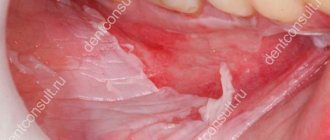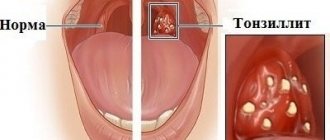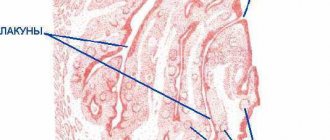Published: 10/22/2021 15:15:00 Updated: 10/25/2021
Sore throat is a disease of an infectious nature, manifested by acute inflammation of the lymphoid tissue of the pharynx. Most often the process affects the palatine tonsils, but other structures of the lymphadenoid pharyngeal ring can also be affected - the lingual and pharyngeal tonsils, lateral ridges or granules of the posterior pharyngeal wall.
The pathology in question is characterized by symptoms of intoxication, increased general temperature, sore throat that worsens during swallowing, enlarged and painful cervical lymph nodes. The palatine tonsils and arches are swollen, enlarged, bright red, and may have a white or dirty yellow coating.
Treatment of sore throat includes local treatment with antiseptics, painkillers and anti-inflammatory drugs, antibiotic therapy and detoxification measures. If complications develop or the process becomes chronic, surgical intervention may be required.
Causes of sore throat
Most often, inflammation is caused by the activity of beta-hemolytic streptococcus group A. Among the possible causative agents of the disease are also adenovirus, staphylococci, pneumococci, parainfluenza virus, mycoplasma, chlamydia, rhinovirus, respiratory syncytial virus, spirochete, Epstein-Barr virus, diphtheria bacillus, enterovirus Coxsackie B, fungi.
The risk of developing a sore throat increases when exposed to the following factors:
- general or local hypothermia;
- weakened immunity due to acute respiratory infections;
- fungal diseases;
- chronic pathologies of the nasopharynx, difficulty in nasal breathing, purulent processes and inflammation in the paranasal sinuses;
- caries;
- systematic exposure to irritating substances on the body, work in a smoky or dusty room;
- increased air dryness;
- regular drinking of alcohol, smoking;
- acute and chronic intoxication;
- poor nutrition, lack of vitamins in the diet.
Symptoms of the disease
Sore throat or acute tonsillitis have a pronounced clinical picture. The incubation period lasts from 12 to 48 hours, after which clinical signs appear.
- Increased body temperature (above 39°C, less often 37-38°C). With a sore throat, it is difficult to lower a high body temperature with the help of antipyretics.
- Signs of intoxication are body aches and weakness, headache, chills, dizziness, pain in the chest and heart area.
- Pain and sensation of a lump in the throat. Pain when swallowing.
- Hoarseness of voice.
- Inflammation of regional lymph nodes.
On examination, swelling and hyperemia of the palatine tonsils are revealed. Depending on the type of inflammation, purulent plaque forms on the lacunae or all tonsils.
In some cases, the symptoms of the disease may not be expressed. The temperature may remain within the low-grade range or slightly elevated, accompanied by unpleasant and painful sensations in the throat.
Types and symptoms of sore throat
Depending on the cause, angina may be primary if the site of inflammation is initially localized in the tonsils.
A secondary or symptomatic type of pathology is considered a manifestation of another disease - infectious mononucleosis, diphtheria, scarlet fever, tularemia, typhoid fever, leukemia, alimentary-toxic aleukia, agranulocytosis. Inflammatory damage to the palatine tonsils is called tonsillitis, and to the nasopharyngeal tonsils - adenoiditis. There is also tonsillitis of the lingual tonsil, lateral ridges of the pharynx and laryngeal tonsillitis.
Based on the depth and nature of inflammation of the lymphoid tissue, the following forms of the disease are distinguished:
- catarrhal;
- lacunar;
- follicular;
- ulcerative-membranous;
- necrotic;
- combined.
Characteristic manifestations of any form of angina are general symptoms of intoxication, including increased body temperature, weakness, decreased appetite, headache, as well as enlarged and painful regional lymph nodes.
The incubation period depends on the type of pathogen and the state of immunity, ranging from several hours to a week or more. Other signs of angina, such as sore throat and external changes in the tonsils, may have varying severity depending on the form of the disease.
Catarrhal
The inflammatory process primarily involves the mucous membrane of the tonsils.
The disease begins acutely. The temperature during catarrhal tonsillitis rises within 37.1-38.0 °C, symptoms of intoxication and sore throat during swallowing are moderate. Characterized by enlargement of the lymph nodes located in front of the sternocleidomastoid muscle at the level of the angle of the lower jaw. The palatine tonsils are moderately swollen, their mucosa, as well as the surface of the palatine arches and the soft palate, are brightly hyperemic. The duration of the disease is 2-3 days, after which recovery occurs or a transition to a more severe form occurs.
Viral sore throat occurs with symptoms of ARVI - runny nose, cough. When infected with Coxsackie enterovirus, blistering rashes are observed on the mucous membrane of the palate and tonsils.
Lacunar and follicular
The clinical course of both lacunar and purulent tonsillitis is severe.
Characterized by fever from 38.0 to 40.0 °C, severe intoxication syndrome: headache, general weakness, aches in joints and muscles, pain in the projection of the heart, chills, sleep and appetite disturbances. The pain in the throat during swallowing is sharp, often radiating to the ear. Severe inflammatory changes lead to dysphonia - the voice takes on a nasal tone. Swelling of the tonsils may be accompanied by difficulty breathing and temporary hearing loss. When a child has a sore throat, there may be increased salivation, drowsiness, vomiting, convulsions, and abnormal bowel movements. In the first 2-4 days, the symptoms increase rapidly, and then disappear just as quickly. In the lacunar form of the disease, in addition to swelling and pronounced redness of the mucous membrane, white, irregularly shaped overlays with a yellowish tint appear on the tonsils, which can be easily removed with tweezers. In the case of follicular tonsillitis, suppuration of the follicles occurs; individual pinpoint yellowish formations of regular shape, no larger than a pinhead, appear through the epithelium. The tongue is dry, covered with a white coating. On the 4-5th day, the surface of the lacuna begins to clear, and the purulent blisters gradually disappear.
Necrotic
The most severe form of the disease. A pronounced intoxication syndrome is characterized by persistent fever, impaired consciousness, and repeated vomiting that does not bring relief. Dirty yellow spots with a greenish tint, ulcers and ulcers appear on the surface of the tonsils.
Ulcerative-membranous
Simanovsky-Plaut-Vincent angina is caused by a spirochete and a spindle-shaped rod that constantly live in the oral cavity.
With exhaustion, a pronounced decrease in immunity or hypovitaminosis, opportunistic microorganisms can become active, causing inflammation. The difference between ulcerative membranous tonsillitis and other forms is the one-sidedness of the process. An ulcer with a gray-yellow coating on the surface appears on the tonsil mucosa. Characterized by a putrid odor from the mouth, moderate sore throat and enlarged regional lymph nodes on the same side as the inflammation. Symptoms of intoxication may be absent or mild. The duration of the disease is from 7 to 12 days. After cleansing of plaque, the ulcerative defect heals without scar formation. Extensive ulcerations can lead to bleeding, damage to the periosteum, and perforation of the palate.
Sore throat in adults
It is worth remembering that this disease is infectious in nature. Therefore, if treatment takes place at home, it is necessary to use individual cutlery and try to have less contact with others. In severe cases of acute tonsillitis, it is possible to place the patient in a hospital under the supervision of doctors. Every adult with a high degree of probability has suffered from a sore throat at least once. But, if it occurs frequently, the palatine tonsils increase in size, become looser, deformed, and their protective function—participation in the formation of immunity—is disrupted to such an extent that they themselves become a constant source of infection. In the tonsils, even without an exacerbation of the disease, pus, mucus and food waste begin to accumulate, and purulent plugs form, creating bad breath. All these manifestations are symptoms of chronic tonsillitis. This disease is dangerous because an inflammatory process constantly occurs in the tonsils, leading to frequent exacerbations. In this case, there is the greatest likelihood of complications for internal organs. A chronic process in the palatine tonsils reduces immunity, weakening the body and making it more susceptible to various infections.
Complications of sore throat
During the disease, the infection can spread to neighboring organs, causing otitis media, lymphadenitis, sinusitis, and peritonsillitis. Among the local purulent complications of tonsillitis, one can note the formation of an abscess or phlegmon in the inflamed tissues. Their occurrence is accompanied by a new wave of fever, increasing sore throat, problems with swallowing and breathing. In the case where the pathology is caused by streptococcus, 3-4 weeks after clinical recovery, glomerulonephritis, reactive arthritis or rheumatic carditis may develop due to subsequent autoimmune processes.
Complications
It is necessary to take angina very seriously, since this disease can cause serious complications on the heart and joints in the form of rheumatism, the kidneys can be affected and glomerulonephritis occurs. If you ignore the problem, sore throat may develop into a chronic form, which is called chronic tonsillitis. Lack of timely treatment can lead to abscess of the retropharyngeal space, sinusitis and sinusitis, and otitis media. Purulent inflammation of the neck and inflammation of the mediastinal organs are very dangerous conditions, often resulting in death. Also characteristic are autoimmune lesions of the heart and kidneys, meningitis, sepsis, and rheumatoid arthritis.
Diagnosis of sore throat
At the patient’s initial visit, the doctor collects complaints and anamnesis, specifying the duration and circumstances of the onset of symptoms, and the nature of the pain.
This is followed by a general examination of the patient, a visual assessment of the mucous membranes of the mouth and throat, and palpation of regional lymph nodes. An endoscopic examination of the ENT organs – pharyngoscopy – is mandatory. It allows you to examine the tonsils in detail and thus determine the form of the disease. For angina, the following tests are prescribed:
- Clinical blood test. Inflammation is indicated by neutrophilic leukocytosis with a shift to the left and accelerated ESR.
- General urine analysis. It is possible that protein may appear in the biomaterial.
- Rapid test from the tonsils using diagnostic strips to detect group A beta-hemolytic streptococcus.
- Bacteriological examination of a smear for beta-hemolytic streptococcus and diphtheria. Material is collected from the surface of the palatine tonsils and the posterior wall of the oropharynx before using local antiseptic drugs and taking antibiotics.
- If a patient is suspected of having infectious mononucleosis, a blood test is performed to test for IgM antibodies or to identify the genetic material of the Epstein-Barr virus.
- As part of the diagnosis of herpetic sore throat, enterovirus RNA is determined in the blood and throat smear using the PCR method.
Diagnosis of complications of angina after clinical recovery includes the following laboratory and instrumental studies:
- Control general analysis of blood and urine.
- Rheumatic test. Determination of rheumatoid factor, C-reactive protein, antistreptolysin-O, seromucoid in the blood.
- ECG. The electrocardiogram may show signs of hypoxia and conduction disturbances.
Diagnostics
You can independently suspect a disease in yourself or a child, first of all, by a sore throat and painful swallowing. Often the causes of pain are a cold or an acute respiratory viral infection, which lead to pharyngitis. If the pain is acute, this is a manifestation of a sore throat, but only a doctor can say for sure. There are different criteria for making a diagnosis. One of them is anapestic or collection of data, the causes of the disease, possible contacts with infected people, the presence of throat diseases in relatives. Next, a visual examination is carried out, during which the doctor evaluates the pharynx, tonsils, and performs pharyngoscopy. In order to identify the disease, the doctor takes swabs from the throat to determine the type of bacteria, as well as to determine sensitivity to various antibiotics. 2 hours before taking a smear, it is prohibited to consume food and various drinks. In addition, a general blood test, urine test and an electrocardiogram are performed to monitor treatment and monitor sudden complications. If leukocytosis and a neutrophilic shift are detected in the blood, this indicates a bacterial origin of the disease, and if there is a higher level of monocytes and eosinophils, we can speak of a viral infection.
Treatment of sore throat
Depending on the severity of the patient’s condition, treatment of angina occurs under the supervision of a doctor at home or in a hospital.
Bed rest is mandatory, a gentle dairy-vegetable diet enriched with vitamins, and plenty of warm drinks are recommended. For bacterial sore throat, broad-spectrum antibiotics are prescribed. If the disease is caused by streptococcus, penicillin drugs are used. In case of severe intoxication syndrome, intravenous infusion of glucose-saline solutions is performed. Non-steroidal anti-inflammatory drugs are used as antipyretics and pain relievers.
For sore throat, gargling with alkaline and water-salt solutions and irrigating the pharynx with painkillers and antiseptics are recommended. The use of drugs in the form of a spray for the treatment of sore throat is possible only in adults and children over 3 years of age. With the development of purulent complications of the disease, hospitalization of the patient followed by surgical intervention is required.
Author:
Pugonina Tatyana Alekseevna, Therapist
Treatment
Treatment of sore throat is the responsibility of a therapist; you should contact him at the first suspicion of this disease, and in no case should you self-medicate. Different types of sore throat require different approaches to treatment; there is no universal cure. Many unqualified doctors for any throat disease, even mild sore throat, prescribe antibiotics to the patient, despite the fact that frequent use of these drugs leads to resistance and causes great harm to the body.
If the process is chronic, doctors suggest solving the problem radically by removing the tonsils. However, these approaches are incorrect, since an experienced specialist must first examine the patient and select a competent treatment regimen for him, trying in every possible way to avoid surgical intervention. You should turn to antibiotics as a last resort and only as prescribed by a doctor, because their prolonged and frequent use leads to a decrease in immunity. Also, many throat diseases are caused not by bacteria, but by viruses, against which antibiotics are powerless. Tonsils or tonsils should be removed only as a last resort, when the inflammation is very severe and no other treatment methods help. After all, the tonsils are the body’s protective gates, protecting it from any infections. Also, immune cells are produced in the tonsils; without them, immunity decreases and, if they are removed, the chances of contracting a particular infection increase. After such an operation, you can get quite serious problems with the heart and kidneys, and various allergic diseases can develop. Instead, the doctor may prescribe the use of Iodinol. This drug has a low cost in pharmacies and is much more effective than many expensive medications. With its help, it is recommended to prepare a solution with which to gargle regularly. But “Iodinol” has contraindications due to the fact that it affects the thyroid gland, therefore it is not suitable for autoimmune thyroiditis, pregnant women and nursing mothers. In this case, you can use inexpensive antiseptics such as Chlorhexidine and Miramistin. To treat tonsillitis, they also use a relatively inexpensive and very effective device for home use - a quartz ultraviolet irradiator with special throat attachments.
An important contribution to treatment is increasing immunity and drinking enough fluids. It is recommended to remove sweets and sugary, carbonated drinks from the diet, as sugar is a breeding ground for the development of microorganisms. In case of chronic illness, you should check the health of your teeth, because throat diseases often occur against the background of the fact that there is an infection in the oral cavity.
We have all encountered more than once the problem of treating a sore throat, especially in childhood. And each of us has memories left in our memory, like a fragment of a picture from a movie, a warm bed, tea with raspberries and an anxious mother who is watching you with pain in her heart, putting a cold towel to her forehead, trying to reduce the fever, because... Typically, such infectious and inflammatory diseases of the oral cavity are accompanied by high fever. So what causes a sore throat and how can you cope with the consequences of this disease so as not to provoke complications.
According to medical statistics, infectious and inflammatory diseases of the mouth and throat account for an average of 30% of the total number of diseases of the ENT organs. The main causative agents of this kind of throat infection are bacteria, the so-called pathogenic microorganisms staphylococci and streptococci, which can easily get on the mucous membrane of the throat and provoke inflammation, especially in children, who are traditionally included in the “risk group”. But in addition to pathogens of a bacterial nature, yeast-like fungi of the Candida albicans group and mold fungi of the genus Aspirgillius can also complicate the course of throat diseases, which are difficult to treat and require, first of all, diagnostic measures to identify the causative agent of the infection, both bacterial and infectious in nature, that provoked inflammation, and selection of a treatment regimen that can suppress two pathogens at the same time. And diseases such as pharyngomycosis and laryngomycosis are among the socially significant diseases, because require an individual approach to therapy.
Usually, the presence of an acceptable amount of opportunistic microorganisms produced on the mucous membranes of the nasopharynx, larynx and throat serves as a natural barrier against external infection entering the body, but as a result of exposure to external and internal factors, their volume may increase, and due to additional infection by bacteria and pathogenic microorganisms , diseases of an infectious and bacterial nature can develop, including those aggravated by a fungal infection, such as mycosis of the throat or candidiasis.
It should be noted that fungi of the genus Candida are quite widespread and, as a result, the possibility of getting this infection in public places through shared objects, food, including by airborne droplets is quite high. In addition, the development of this type of infection can be caused by such reasons as uncontrolled and long-term use of antibiotics without special indications, less often, disruption of hormonal levels and the endocrine system, reduced immunity, frequent diseases of a viral nature, childhood, incl. and incorrectly selected therapy for ENT diseases.
Fungal infections of the throat differ from the symptoms of ordinary sore throat of a bacterial nature in the appearance of plaque, which resembles cottage cheese. It is easy to remove, but underneath there is an inflamed mucous membrane, with redness and ulcers. And if a fungal throat infection is caused by fungi of the genus Aspirgillius, then such plaque is quite difficult to remove and has a yellowish tint. It should be noted that the localization of a fungal infection in the mouth and throat is also characterized by the manifestation of symptoms of a common sore throat.
It is quite difficult to detect fungus in the mouth and throat at an early stage, because... at the beginning of infection it usually does not appear, only as the colonies increase. Characteristic symptoms begin to appear gradually, in the form of discomfort, soreness, burning and dryness in the throat, and pain during swallowing. In addition, there is a presence of white plaque in the larynx, tonsils, tonsils and tongue, as well as the appearance of erosive surfaces in the form of ulcers and cracks in the mucous membrane of the throat. Traditionally, the temperature rises, headaches appear, swelling of the nasopharyngeal mucosa occurs, as well as characteristic symptoms of general poisoning and intoxication.
In children, the course of fungal tonsillitis is much more severe than in adults, because In childhood, the phenomena of intoxication in the body and pain syndrome are especially pronounced. The child becomes weakened, more capricious, and refuses to eat. In addition, when removing plaque from the mucous membranes of children, the delicate skin may be injured, and sometimes minor bleeding may occur. Also, in children there is a high probability of dysbiosis and diarrhea, due to the fact that yeast-like fungi of the genus Candida can move into the intestinal tract and provoke intoxication and characteristic symptoms of poisoning.
The initial diagnosis for the presence of fungi in the throat can first be carried out independently by examining the mouth and throat for the presence of white plaque. But it is important to remember that only a doctor can make a correct diagnosis, because... Only with the help of laboratory diagnostics can one identify the pathogen that has caused infectious and inflammatory processes in the nasopharynx and oral cavity and select the necessary treatment regimen for this disease.
Instrumental research or laboratory diagnostics includes the following studies:
1. Laboratory mycological research - analysis of biomaterial (smear from the throat), provides the most accurate determination of the pathogens that caused a fungal infection of the throat.
2. A skin test with fungal allergens is carried out by introducing a fungal allegory test under the skin. This research method is necessary to establish the most accurate diagnosis and also to identify the chronic stage of the disease.
3. An immunological test is carried out to detect antibodies to the fungus in the blood.
These studies are the most informative and will allow the specialist to choose the right tactics for treating emerging lesions of the throat mucosa with fungal colonies.
After the doctor has made the correct diagnosis and identified the causative agent of the infection, the next step towards recovery is treatment of the fungal infection. The main goal is to get rid of a large number of pathogens in the throat, restore microflora, the integrity of the mucous membranes and strengthen the immune system. Treatment of fungal tonsillitis is carried out comprehensively, combining traditional medicinal methods in conjunction with a balanced diet. First of all, antifungal agents are prescribed, and if this therapy does not give the desired effect, antibiotics are prescribed. The course of treatment can last up to 2 weeks, but in acute forms of the disease it is necessary to prescribe additional therapy in the form of vitamins, antiallergic agents and probiotics containing bifidobacteria and lactobacilli to restore normal gastrointestinal microflora. In addition, local antiseptics are additionally prescribed.
One of these drugs, which has proven itself in the treatment of ENT diseases, including purulent-inflammatory infections of the oral cavity, nasopharynx and throat, is the modern anti-inflammatory drug of plant origin Abisil, created on the basis of natural terpenoids of Siberian fir. The drug has pronounced anti-inflammatory, antibacterial, analgesic, wound-healing, and anti-exudative effects. It should be especially noted that microbiological studies of the drug Abisil revealed a wide range of antibacterial activity against gram-positive and gram-negative strains and various types of pathogenic microbes, often causing purulent-inflammatory diseases. Abisil is especially sensitive to staphylococci and streptococci, which are the main pathogens for throat diseases, in particular purulent sore throat. In addition, the drug was found to have antifungal activity against yeast-like fungi of the genus Candida and mold fungi Aspirgillus. But the most valuable thing about it is that microorganisms do not become resistant to the drug, and therefore it can also be used in complex cases when inflammation is caused by antibiotic-resistant microflora. Possessing a complex and multidirectional effect, Abisil helps to get rid of purulent sore throat in a short time, including sore throat aggravated by a fungal infection. And in most cases, when traditional therapy for the treatment of fungal tonsillitis, including the simultaneous use of antibiotics and antimycotics, does not give the desired effect, Abisil therapy acts as an alternative to antibiotic therapy and shows a positive effect in the treatment of these pathologies. In addition, Abisil helps restore the activation of the protective functions of the mucous membrane and restores the balance of the microflora of the nasopharynx, in contrast to local synthetic antiseptics, which suppress both pathogenic and conditionally pathogenic microflora of the mucous membrane of the nasopharynx and throat.
The drug does not accumulate in the body, does not have teratogenic or embryotoxic effects and therefore can be used in all age groups, incl. and in children, and is indicated for use in the treatment of purulent-inflammatory throat infections. But in any case, to provide effective assistance and prescribe therapy for fungal infections of the throat, it is necessary to consult a doctor and his observation during the treatment. It should be noted that treatment with Abisil is simple and accessible. For tonsillitis, laryngitis, pharyngitis, it is recommended to irrigate the mucous membranes of the mouth with the drug 2-3 times a day after meals. This can be done using a pipette or a syringe through a special nozzle, distributing Abisil in an amount of 1-2 ml to the area of the palatine tonsils and adjacent palatine arches, larynx and pharynx. In this case, it is additionally necessary to drip 2-3 drops of the drug into the nose. The duration of treatment is 1-3 weeks. In case of chronic disease, the course of treatment can be repeated after 1-2 months. After the procedure, it is not recommended to eat, drink or rinse your mouth for 3-4 hours. For fungal infections of the oral cavity, it is recommended to treat the affected areas of the oral mucosa 3-4 times a day with a cotton swab moistened with the drug. In addition, rubbing the drug Abisil into the front of the neck, into the area of the submandibular and cervical lymph nodes is also effective. In rare cases, a short-term burning sensation may occur at the site of application of the drug, but it quickly passes. Combining the drug with other external agents is not recommended.
Another component of a full fight against fungal infections of the mouth and throat is a balanced diet, which additionally helps to get rid of mycosis. The fact is that fungi can feed on the foods that we eat and therefore, when forming a diet for the treatment of fungal sore throat, we should exclude foods that can provoke the growth of fungi, thus depriving them of additional nutrition. First of all, you should exclude alcohol, sugar, baked goods, baked goods, sweets, condensed milk, jams and preserves, dairy products, as well as canned foods containing vinegar. And the following foods must be included in the diet: meat, fish, eggs, cereals, legumes, fresh vegetables and herbs, garlic, spices, mineral water and tea.
You should pay attention to the fact that with improper therapy or neglect of the prescribed treatment by a doctor, complications of the disease can be provoked, in which the mucous membrane of the throat is destroyed and open wounds and ulcers appear on it, into which infection can re-enter and provoke secondary infection in the form of bacterial inflammation . Repeated inflammation is characterized by the appearance of abscesses and abscesses of the larynx. In addition, the development of fungi in the body can also cause a reaction in the form of an allergy, and most often, mycotic eczema can occur, which manifests itself in the form of peeling and the occurrence of inflammation and wounds on the skin. Another complication may be the occurrence of recurrent tonsillitis, which can occur frequently, once every 1-1.5 months, up to 10-12 times a year, and this is associated with the life cycle of the fungus.
What preventive measures must be taken so that the fungus in the throat does not develop further and does not develop into a chronic disease with frequent relapses. First of all, it is necessary to monitor hygiene and cleanliness of the oral cavity, and avoid contact with infected people. Take antibiotics only as prescribed by a doctor, do not self-medicate and do not take antibiotics longer than the prescribed course. Make it a rule to visit the dentist for a preventative examination of the oral cavity and begin treating the disease immediately, without delaying it for later, and do not forget to strengthen your immune system. The most important rule in the treatment of fungal infections of the oral cavity and larynx is to identify the cause of the disease, eliminate the pathogen and adhere to the therapy prescribed by the doctor and a set of preventive measures so that possible relapses and complications do not arise in the future.
How dangerous is a sore throat?
Tonsillitis is dangerous if complications develop. If your throat hurts with a sore throat for more than 7 days, you should think about possible inflammation of the tissues surrounding the tonsils (peritonsillitis), their suppuration and the formation of a peritonsillar abscess. If your ear begins to hurt and your hearing decreases, it means that otitis media has developed.1
Late complications of acute tonsillitis include:
- rheumatism;
- glomerulonephritis;
- infectious-allergic myocarditis;
- polyarthritis;
- cholecystocholangitis1,2.
Timely and competent treatment can prevent these complications of angina.
Up to contents









